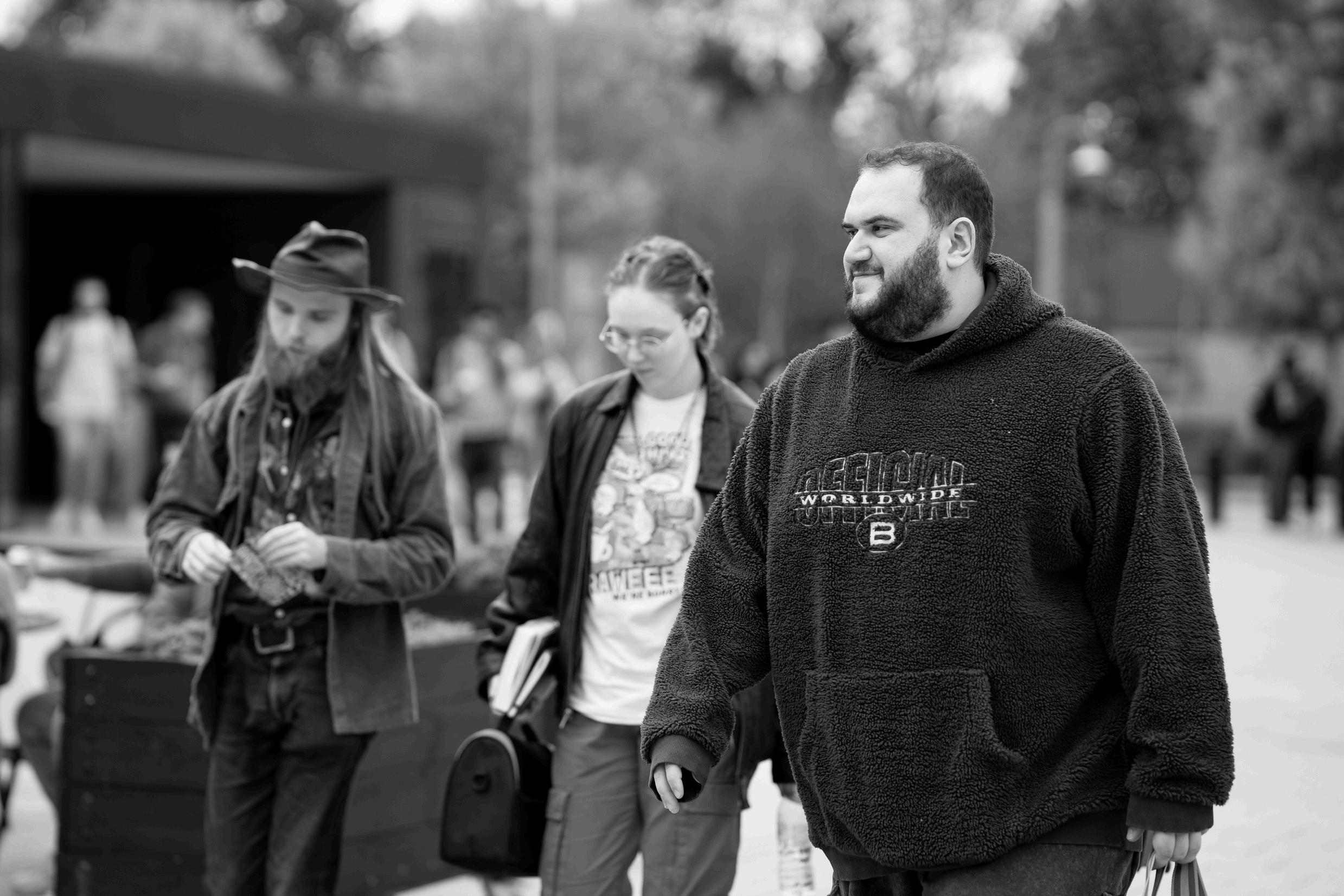COMMUNITY PROJECT REPORT











HertfordshireBusinessSchool(HBS)
SchoolofCreativeArts(CTA)
SchoolofHealthandSocialWork(HSK)
SchoolsofLaw(LAW)
SchoolofLifeandMedicalSciences(LMS)
SchoolofPhysics,EngineeringandComputerScience (SPECS)
SchoolofSocialScience,Humanities&Education(SHE)
The Community Project reviewed 1,649 student responses from April to May 2023. The survey examined how respondents felt about the university community around them and the challengestheymayface.
SSHE 7%
The following themes were surveyed: Cost of Living, part-time jobs, communication, extracurricular activities, commitments and campus areas. We had both open and closed questionsaboutthesetopics.TheCostof Livingthemehadthemostimpactonthe lives of respondents as some struggled to afford basic necessities, such as rent or groceries. This also impacted their ability to join societies, sports clubs and gyms. The theme of communication focused on how respondents received information from the university and their academic staff, which was largely positive.Extracurricularactivitiesfocused on how respondents spent their time outside lectures, while commitments looked at how respondents prioritised different aspects of their lives. Questions on campus areas looked at how respondentsuseduniversitycampuses.
Responses were collected from all Schools of Study across the university (Figure 1). The majority of these came from Hertfordshire Business School students, making up 38%(N=628/1649)ofthetotalresponserate.Responseswerealsodisproportionally highforinternationalstudents,with66%(N=1093/1649)ofthetotalresponserate.
TherewasasignificantnumberofrespondentswhohadbeenimpactedbytheCost ofLivingCrisis,whichhascausedgreaterfinancialhardshipforsomerespondents,as well as disruption to their academic experience. 30% (N=467/1546) of respondents stated they could not afford food comfortably each week or month and 45% (N=687/1542) of respondents could not comfortably afford rent. This did vary betweenschools,butHertfordshireBusinessSchoolandHertfordshireLawSchoolhad particularly low scores regarding rent affordability each week/month (51% vs. 57%, respectively). International respondents were more likely to struggle with their rent comparedtohomerespondents(63%vs51%).Only27%(N=407/1494)ofrespondents agreed their student loans covered their monthly expenses. 26% (N=191/735) of female respondents agreed that their student loan covered their monthly expenses, whichwassignificantlylowerthanthemalerespondents(29%,N=191/668).
Respondentswerealsoaskediftheyever supplemented their income with other means such as gambling (online and in person), credit cards, other loans (e.g., pay day loans), payment deferral options or sex work (online and in person).46%(N=517/1113)ofrespondents admitted they had asked for parental or family loans, 19% (N=206/1113) of respondents used other loans to support themselvesand18%(N=196/1113)turned to credit cards. Respondents from the School of Health and Social Work (HSK) agreed that they were supported financially by their family/friends (35%, N=33/94) but credit cards had been used often too (34%, N=32/94).
Unfortunately, due to interest rates, this canhaveanegativeaffectinthefutureif th d t i bl t them


69% (N=1067/1539) of respondents stated that increased living costs impacted their ability to travel to campus when needed and 34% (N=532/1546) of respondents struggled to afford commuting costs each month. 76% (N=231/354) of respondents who lived off campus felt impacted by the increased cost of commuting onto campus when needed. Accommodation was examined and respondents were asked what they look at when choosing where to live Overwhelmingly, the most significant factor was price (58%, N=895/1533), followed by distance from campus(21%,N=327/1533).
Cost of living also had a detrimental result on society memberships and other extracurricular activities. 70% (N=1084/1540) of respondents felt the cost of living impactedtheirabilitytojoinsocietiesand77%(N=1190/1542)ofrespondentsagreed that cost of living affected their ability to join the gym, sports clubs and any other sportingactivities.ForBlack,AsianandMinorityEthnicrespondents,thecostofliving had a greater impact on joining societies compared to white respondents (79% vs 46%) and this trend continued as Black, Asian and Minority Ethnic respondents struggledtojoinsportsclubs,gymsandsportsactivity(81%vs65%).
OnlineGambling InPersonGambling CreditCards PaymentDeferralOptions
Figure2 Respondentresponsesregardingsupplementingtheirincome
Thecurrentfinancialsupportforinternationalstudentsarenofitfor purpose!GiventhenumberofrespondentsatUHthatareinternational,and thefundtheycontribute.Ibelievealotmoresupportshouldbeinplacethan this.
Questions around commuting, childcare responsibilities and timetabling were asked to determine how respondents prioritised different obligations. Respondents were asked to select three commitments they prioritised and the top three answers were asfollows:
Studies/academia(92%,1332/1445)
Family(69%,996/1445)
Jobs(56%,809/1445)
Theirsociallifewasrankedasthefourthmostpopularanswer(40%,577/1445).
Female respondents were more likely to be affected by childcare responsibilities as 11% (N = 80/716) of female respondents stated that duties of this nature had prevented them from attending their lectures 16% (N = 113/716) of female respondents also reported that their childcare responsibilities had prevented them accessing extracurricular activities on campus. This trend is also seen in Asian respondents,whereby14%(N=106/754)statedthatchildcareobligationsprevented themfromattendinglectures.23%(N=53/230)ofBlackrespondentsnotedthattheir childcare responsibilities stopped them from attending extracurricular activities
Internationalrespondentswerealsogreatlyaffectedbychildcarecommitments.14% (N=127/934)ofinternationalrespondentsreportedsimilarresultsasitaffectedtheir abilitytoattendlecturesoncampus.
Regarding commuting difficulties, postgraduate respondents were largely affected bytheseas60%(N=539/938)ofrespondentswereunabletoattendextracurricular activities on campus due to their commute. 56% (N = 67/119) of respondents who declared a disability felt that their commute barred them from accessing extracurricular activities on campus and 67% (N = 696/1046) of respondents also struggledtoattendextracurricularactivitiesoncampusduetotheircommute.
Extracurricular activities looked at how respondents used their time outside of their studies.57%(N=839/1482)ofrespondentsstatedtheypreferredtoattendacademic eventsratherthansocialevents.However,respondentsfromtheSchoolofHealthand SocialWork(HSK)andtheSchoolofSocialScience,HumanitiesandEducation(SHE) had the lowest agreement rate for this statement (44% and 41%). Participation with physical activity was examined, with 11% (N=159/1481) of respondents stating they regularly go to the gym and 27% (N=396/1477) of respondents regularly attending ActiveStudentsactivities.
In terms of a more traditional social setting, 44% (N=656/1480) of respondents regularlyattendeventsatTheForum,59%(N=870/1476)liketoattendsocietyevents and 46% (N=674/1475) like to regularly get involved with SU events. Respondents frombothHSKandSHEhadloweragreementratescomparedtorespondentsinother schools when asked about extracurricular activities HSK and SHE respondents were also less likely to engage with things like the gym, The Forum and society events. In contrast,internationalrespondentsweremorelikelytoengagewithsocialactivitylike The Forum (54%, N=523/967), compared to less interest from home respondents (26%,N=133/513).
Respondents were also asked if they felt they were part of their school/programme community and 64% (N=941/1478) agreed. 64% (N=942/1482) of respondents felt part of the university community but overall, 31% (N=459/1475) of respondents reported that they did not feel part of any community. 41% (N=28/68) of Law School respondentsfelttheywerenotpartofanycommunityattheuniversity.Respondents


Abouttheeventsthathappenatcollegelane,especiallyattheForumoratthe HuttonhubneedtobepublishedorpromotedattheDeHavcampus,asmostof therespondentsareunawareofwheretolookfortheinformation.Apartfrom receivinguniversitymailsandsocialmedia,acollegeradioismoreengaging andcanhelpcommunicatethenecessaryinformation.

RespondentsfromtheHertfordshireBusinessSchool(HBS)reportedstrugglingdueto the cost of living. 32% (N=188/588) of respondents were unable to afford food comfortably each week/month and 49% (N=287/588) of respondents struggled to affordtheirrenteachweek/month.35%(N=206/588)ofrespondentscouldnotafford their commuting costs each month and 76% (N=445/588) of respondents agreed thatincreasedlivingcostsaffectedtheirabilitytoattendclasses.
Costoflivingalsohadanegativeimpactonthe social aspects of the respondents. 77% (N=448/584) of respondents found it financially difficult to commit to societies and 80% (N=466/585) struggled to join the gym and sports clubs 48% (N=221/463) of respondents from HBS had loans from their family&friendstosupportthemthroughoutthe academic year. The second most popular answer was other loans, such as payday loans or bank loans (20% N=92/463) and they also used credit cards to supplement their income (13%,N=60/463).Only27%(N=152/561)ofHBS respondents felt their student loans covered theirmonthlyexpenses.
Respondents from HBS also supported themselves by having a part-time job. 60% (N=350/586)statedtheywereworkingpart-time,with58%(N=201/347)working16to 20 hours per week. This was the highest percentage across the schools. This is the maximum number of hours international respondents can work due to visa restrictions 96% (N=331/346) of respondents worked off campus and only 24% (N=83/347)wereworkingjobsrelatedtotheircourse.
Overall, respondents were well engaged in activities and societies around the university. They preferred to attend academic events more than social events and this was significantly higher than other schools (P < 0.05). Respondents were significantly more likely to go The Forum (P < 0.05) and were more likely to go to eventsheldbysocieties(P<0.05).Ontheotherhand,respondentsweresignificantly less likely to attend the gym on campus (P < 0.05) but still liked to attend the Active Students sessions regularly (35%, N = 191/550). This may indicate that respondents did not want a long-term commitment and preferred to opt for a short-term alternative. Respondents also liked to attend events held by the SU more than the other schools (P < 0.05). 23% (128/552) expressed that they experience loneliness daily.
Respondents from HBS were significantly more likely to feel part of their school/programme community than their counterparts (P < 0.05) and were significantly more likely to feel part of the university community compared to other schools(P<0.05).
45% (N=243/535) of respondents from HBS reported their academic timetable preventedthemfromtakingpartinextracurricularactivitiesand60%(N=319/535)of respondentsfelttheircommutewasabarrier.Thiswassignificantlyhigherthanother schools(P<0.05).Childcareresponsibilitieswerealsoacontributingfactortowardsa lack of engagement. 17% (N=89/535) of respondents stated their childcare responsibilitiesbarredthemfromattendinglecturesoncampusand18%(N=98/535) ofrespondentsexpressedconcernsthattheirchildcareresponsibilitiesrestrictedtheir access to extracurricular activities on campus. Both these areas, in comparison to otherschools,wereparticularlyhigh(P<0.05).


47% (N=53/113) of respondents from the SchoolofCreativeArts(CTA)statedthey were working in a part-time job, which is lower than the average of 59%. The majority of respondents who did work a part-time job worked between 16 – 20 hours per week (36%, N = 19/53). Moreover, 26% (N = 14/53) of respondents worked more than one job, which was significantly high (P < 0.05) and83%(N=44/53)workedoffcampus.
81% (N = 43/53) of respondents were not workinginarolethatwasrelatedtotheir degreeorcourse.
CTA respondents kept up-to-date with events and other activities around the university by viewing the university’s emails(61%,N=68/112).51%(N=57/112) of respondents also viewed the Herts SU emails,and51%(N=57/112)viewedHerts SU’s social media channels. Like respondents from other schools, they viewed the SU’s social media more than the university’s (33%, N = 37/112). CTA respondents actively looked for information about their course (67%, N = 74/110), followed by events and activities oncampus(59%,N=65/110)
57% (N=63/111) of respondents felt the academic staff replied in an appropriate time frame and the information they providedwasaccurate(76%,N=84/110).
76% (N = 84/111) of respondents felt the informationtheyprovidedwasuseful.
Overall, CTA respondents’ agreement rate was lower than other schools when asked about involvement in extracurricular activities. Just 28% (N = 31/110) of respondents stated they regularly go to The Forum, which was lower than the average of 39%. Only 37% (N = 40/109) of respondents like to attend society events, whilst the average agreementratesitsat51%.However,CTA respondentsdoliketoattendthegymon campus (16% N = 18/110) which is higher thantheaverageof11%.
In terms of community, 53% (N = 58/110) of respondents felt they were part of the university community and 53% (N = 58/110) felt part of their school/programme community. This is significantly lower than some other schools (P<0.05). 34% (N = 37/109) of respondents stated they did not feel part ofanycommunity.
Respondents from the School of Health and Social Work (HSK) faced difficulties regarding the cost of living. 30% (N = 39/129) reported they were unable to afford groceries/food comfortably each month. This was significantly lower than other schools(P<0.05).40%(N=52/129)ofrespondentsalsostrugglewithrentpayments eachweek/month Increasedlivingcostsaffectedtheirabilitytotravelontocampus when needed (56%, N= 72/128), with 39% (N = 50/129) finding it difficult to afford commutingcostseachmonth.
Socialliveswerealsoaffectedbythecostoflivingas59%(N=75/128)ofrespondents felttheywerenotabletojoinsocietiesasaresult.Thisextendedtosportsclubs,gym memberships and other sporting activities, with 68% (N = 88/129) being affected by this. Only 25% (N=31/123) of respondents agreed their student loan covers their monthlyexpenses.
Respondents were also asked if they supplemented their income and 35% (N = 32/94) said they had asked their family and friends for loans. This was closely followed by credit cards, as 34% (N = 32/94) of respondents disclosed they used themtosustainthemselves.Thisissignificantlyhigherthanotherschools(P<0.05).
Socially, respondents from HSK did not attend events and sports activities around campus and were lower than average in nearly all agreement rates. For example, respondents were asked if they attended The Forum regularly and 31% (N = 39/126) agreed, but this came in lower than the average rate of 39%. 39% (N = 49/125) of respondentslikedtoattendsocietyevents,butagainthiswaslowerthantheaverage agreement (51%). Only 9% (N = 12/127) of respondents regularly went to the gym at the university’s Sports Village and just 8% (N = 10/127) regularly attended Active Studentsevents,whichwaswaydownfromtheaverageagreementrateof21%.
Regarding community, 58% (N = 74/127) of respondents felt part of their school/programme community but only 45% (N = 57/127) felt part of the university community, whilst the average agreement rate was 58%. 32% (N = 41/127) of respondentsfelttheywerenotpartofanycommunityattheuniversity.Respondents fromHSKhadthelowestagreementratearoundfeelingsoflonelinessonadailybasis (13%,N=16/127)andtheaverageratewas24%.Thiswasalsosignificantlylowerwhen comparedtootherschools(P<0.05)
Similar to respondents in HBS, respondentsintheLawSchoolalsoseem tobestrugglingwithcoveringthe costof essentials, such as groceries and rent. 37% (N=27/73) of respondents were not able to afford groceries/food each week/month and 43% (N=31/72) were unable to afford their rent. 66% (N=48/73) stated that Increased living costs affected their ability to travel into campus when needed. Only 24% (N=17/72) of respondents said their student loan covered their monthly expenses and 61% (N=42/69) felt that the price of accommodation was the most important factor when selecting theiraccommodation.
61%
23% (N = 15/66) of respondents stated thattheiracademictimetableprevented them from taking part in extracurricular activities, but this was significantly lower than the average of 42%. 8% (N = 5/66) of respondents reported that childcare responsibilities affected their lecture attendance on campus and 15% (N = 10/66) felt their childcare responsibilities prevented them from accessing the campusforextracurricularactivities.This was higher than the average of 12% and it is significantly higher than some other schools(P<0.05).
This trend continued as 18% (N = 12/66) of respondents reported that their part time jobs affected attendance to oncampuslecturesand30%(N=20/66)of respondentsreportedthattheirparttime job prevented them from extracurricular activitiesoncampus.
From the School of Life and Medical Science (LMS), 56% (N=101/179) of respondents stated they had a parttime job. Similar to respondents in HBS, 30% (N=30/100) of respondents worked between16to20hoursperweek.Again, this is the maximum amount international students can work per week. Of note was the number of respondentsthatweworkingmorethan one job alongside their studies, at 24% (N=24/101). 94% (N=95/101) of respondents were working off campus andjust29%(N=29/101)ofrespondents were working a job related to their courseordegree
Regarding the academic timetable, 51% (N=87/170) of respondents felt it was demanding and prevented them from extracurricular activities. For 55% (N=94/172) of our respondents, the need tocommuteontocampuspreventsthem from accessing extracurricular activities atuni.11%(N=18/170)ofrespondentsfelt their childcare responsibilities restricted their access to lectures on campus and 12% (N=20/170) felt their childcare responsibilities stopped them from attending extracurricular activities here. This was also the case for part-time work, as respondents who were working felt it hindered them from joining extracurricularactivities(31%,N=51/167).
Communication focused on how LMS respondents received information around their course, events at the university, exams and any other important information. 71% (N=122/173) of respondents looked at university emails, followed by Herts SU emails (62%,N=107/173).LMSrespondentspreferredtoviewHertsSU’ssocialmediachannels rather than the university’s (38% vs. 27%). The least viewed form of communication werefliersandpostersasonly14%(N=25/173)ofrespondentssaidtheylookedatthis typeofpromotion.
Respondents actively looked for course updates (69%, N=118/171), followed by events andactivitiesheldoncampus(49%,N=83/171)andpart-timework(48%,N=82/171). LMS respondents were significantly more likely to look for information regarding wellbeingsupportcomparedtosomeotherschools(P<0.05).RespondentsfromLMS had a low agreement rate regarding academic staff responding in an appropriate timeframe(73%,N=126/173)andjust79%(N=136/172)feltthattheinformationthey received from academic staff was accurate. Only 80% (N=136/170) of respondents thought the information they received was useful which was significantly lower than the average (85%). They were also significantly less likely to find the information usefulcomparedtotheircounterpartsinotherschools(P<0.05).
Respondents from the School of Physics, Engineering and Computer Science (SPECS) used university emails to keep up to date with the events and activities acrossthecampuses(67%,N=231/345) and 61% (N = 210/ 345) also looked at Herts’ SU emails Similar to respondents fromLMS,posters&flyerswerelookedat the least (15%, N = 52/345). 43% (N = 148/345) viewed Herts SU’s social media channelswhile35%(N=120/345)viewed theuniversity’s.
Respondents were also asked what informationtheyproactivelyseek.76%(N = 260/341) look for course updates and 55% (N=188/341) look for events and activities on campus. Part-time work opportunities came in just behind this (52%, 176/341). This order did differ from respondents in LMS but the information theyviewedwasthesame.
77% (N= 266/344) of respondents agreed that their academic staff were quick with their responses and the information they received from the staff was and
Respondents were asked if their academic timetable prevented them from taking part in extracurricular activitiesand52%(N=174/332)feltthisto bethecase.Thiswassignificantlyhigher than other schools (P < 0.05) and the averageof42%
Commuting was also an issue for SPECS respondents as 56% (N=186/332) reported that commuting prevented them from accessing the campus for activities. 10% (N=34/332) felt their childcare responsibilities affected their abilitytoattendon-campuslecturesand 11% (N=36/332) said their childcare responsibilities stopped them from attendingextracurricularactivitiesatuni.
Thetrendcontinuedwithpart-timework. 17%(N=57/331)ofrespondentsfelttheir part-time job(s) restricted them from accessing lectures on campus and 30% (N = 99/332) said it prevented them from attending extracurricular activities here.


SPECS respondents preferred to attend academic events rather than social events (61%, N=210/343) and this was significantly higher than the average of 51%. 13% (N = 43/344) of respondents also liked to attend the gym regularly and this was also higher than the average of 11%. Respondents were also regularly going to the Active Students activities (34%, N = 116/344) and again thiswashigherthantheaverage(21%)
Regarding The Forum, 61% (N = 210/345) ofrespondentssaidtheyattendregularly which was not only the highest agreement rate, but significantly higher compared to other schools (P < 0.05). 70%(N=238/342)ofrespondentsattend society events regularly and 59% (N= 201/343) like to attend SU events regularly (P < 0.05). Regarding community in the university, 67% (N = 231/345) of respondents felt they were part of the university community and 69% (N =237/344) of respondents felt they were part of their school/programme community. However, 30% (N=104/343) of respondents did not feel part of any community. Lastly, 28% (N = 95/345) of respondentsfeltlonelyonadailybasis.
IgenuinelywouldlikeUniversitytocreateagroupchatthatallow respondentsfromthesamecountrytogetconnectedwitheach


Respondents from the School of Social Science, Humanities and Education (SHE) had some financial difficulties due tothecostofliving.74%(N=84/114)were able to afford food comfortably each month and this was the highest agreementrateofallschools.Itmustbe noted that 26% (N=30/114) of respondents still faced food scarcity each month. 62% (N = 71/114) of respondents were able to pay their rent each week/month and 72% (N = 82/114) of respondents could afford commuting costs each month. This was significantly lower than other schools (P < 0.05). However,58%(N=66/114)ofrespondents felt that increased living costs impacted theirabilitytotraveltocampus.
Socially, SHE respondents struggled to takepartinactivitiesandevents.58%(N = 66/114) of respondents stated that the cost of living affected their ability to join societies and 74% (N = 84/114) of respondents struggled to join sports teams/gym/sports activities. Only 25% (N= 28/110) of respondents had their monthly expenses covered by their studentloans.
SHE respondents were similar to HSK respondents in that they too were below the average agreement rates in nearly allaspects.Theydid,however,attendthe gym on campus more regularly (12%, N=13/110)andthiswasslightlyabovethe average of 11%. On the other hand, only 11% (N = 12/110) of respondents attended the Active Students programme regularly. This trend continues as only 24% (N=26/110) regularly go to events at The Forum. This was the lowest agreement rate out of the seven schools (P < 0.05). Finally, only 39% (N = 43/110) of respondents like to attend society events, which is significantly lower than otherschools(P<005)
Intermsoffosteringcommunityfeelings, 53% (N = 58/109) of respondents feel part of their school/programme community and 53% (N = 58/110) of respondents feel part of the university community.However,35%(N=35/110)of respondents stated they do not feel part of any community at the university and 25%(N=27/110)reportedtheyfeellonely onadailybasis.

ENHANCETHEFINANCIALSUPPORTAVAILABLETOALL STUDENTSTOHELPWITHTHEINCREASINGCOSTOFLIVING
Many respondents reported having concerns about their ability to pay their monthlyrentorfoodcosts.Almost3in4 respondents (73%, N = 1,087/1494) reported their student loans did not cover their monthly expenses. Respondents also reported they were turning to different means to supplement their income, with 46% (N = 517/1113) asking family and friends for loans and 19% (N = 206/1113) using different forms of loans to support themselves. This reliance on other streams of income highlights the insufficiencyofstudentloans.
2.Further financial support should be made available to ensure students are able to afford groceries, housing and commuting costs. This can be achieved by widening the groups of students eligible to access financial support for livingexpenses.
Overall, there are differences in levels of engagement across the schools. Students from HBS and SPECS are more likelytoattendsocietyevents,TheForum &ActiveStudentsactivitiesthanthosein other schools. Respondents from CTA, HSK and SHE had the lowest engagementacrosstheschools.Schools should push to have more engagement atevents.
The SU have pledged to hold events which are aimed at certain schools and cohorts, targeting those that currently (and traditionally) have less engagement. We’re also asking for schools to encourage students to get involved with extracurricular activity whereappropriate.
Almost 1 in 4 (24% N = 355/1483) respondentsreportedtodailyfeelingsof loneliness.Thisisasignificantnumberof students so a bigger push for mental health support should be considered at the university. SPECS respondents had the highest agreement rate (32% N =), whilst HSK respondents had the lowest (13% N = 16/127). There is also a difference in loneliness agreement rates regardinginternationalrespondentsand homerespondents(26%vs20%).
Schoolsshouldensurethattheirstudents are aware of wellbeing services at the university, especially SPECS who have larger volumes of students needing this kind of support. It is also advised that awareness of these services is raised more during the induction period for internationalstudents,asthiswillhelpto increasetheirknowledge&confidencein accessingsupportofthisnature.
EXPLORETIMETABLEFLEXIBILITYANDUNDERTAKEFURTHER RESEARCHTOUNDERSTANDTHENEEDSOFCOMMUTINGSTUDENTS
Acrosstheschools,respondentshaddifferentcommitmentsoutsideoftheirstudies. Some of these commitments, prevented them from accessing lectures and extracurricular activities. For example, 17% (N=89/535) of HBS respondents stated their childcare responsibilities restricted access to lectures on campus and 18% (N=98/535) of did not attend extracurricular activities for the same reason. This trend is also prevalent in LMS, where 11% (N = 18/170) of respondents felt their childcare responsibilities prevented them from accessing lectures on campus. Regarding commuting difficulties, postgraduate respondents were largely affected by commuting as 60% (N = 539/938) of respondents were unable to attend extracurricularactivitiesoncampusasaresult.
Offering further flexibility within timetabling is advisable as we look to lessen the impact of any barriers affecting students’ ability to come to campus and engage with their studies. It is also recommended that, in conjunction with Estates and ULiving, further research is undertaken to understand the rationale for students choosing to live elsewhere (e.g. Luton). Following this, a strategy should be developedthatcommitstosupportingcommutingstudentsmore.

